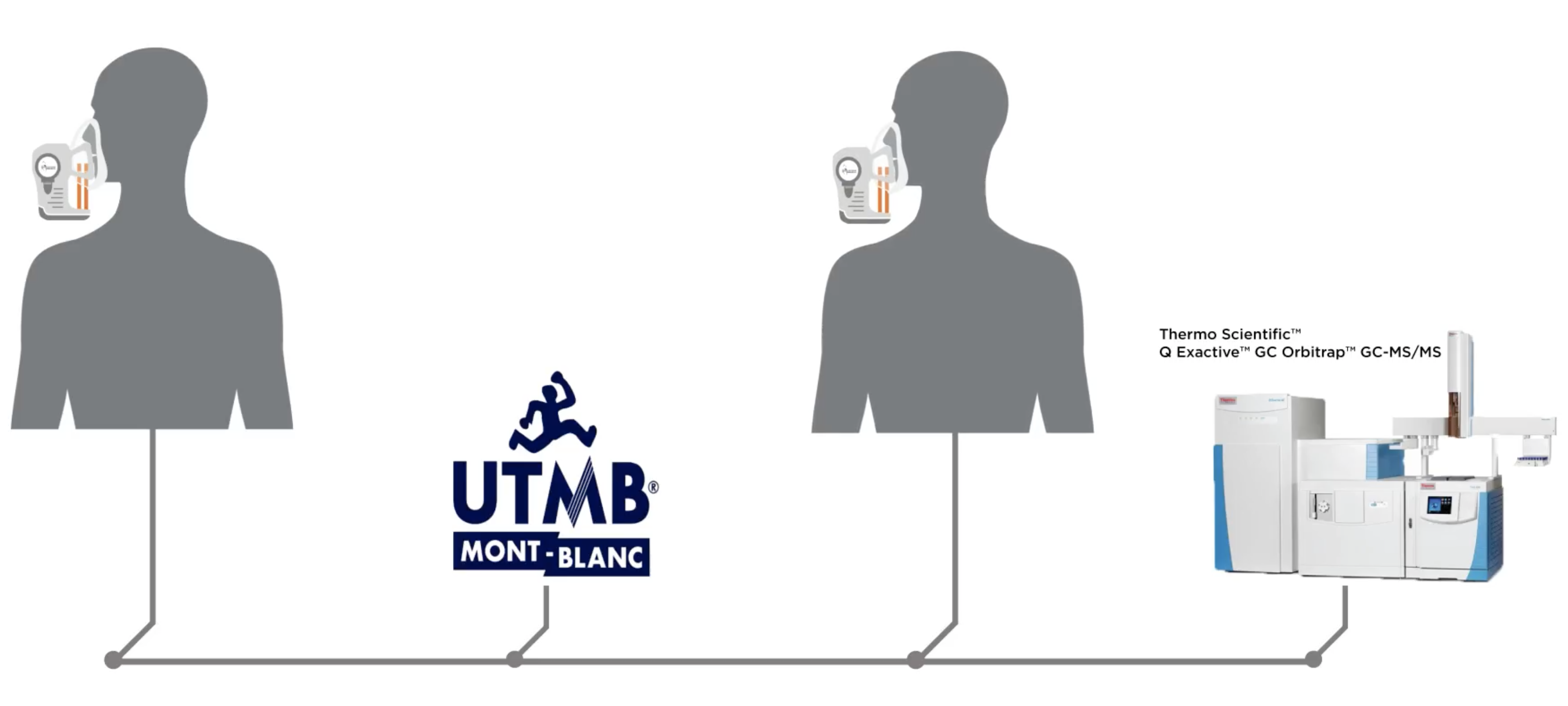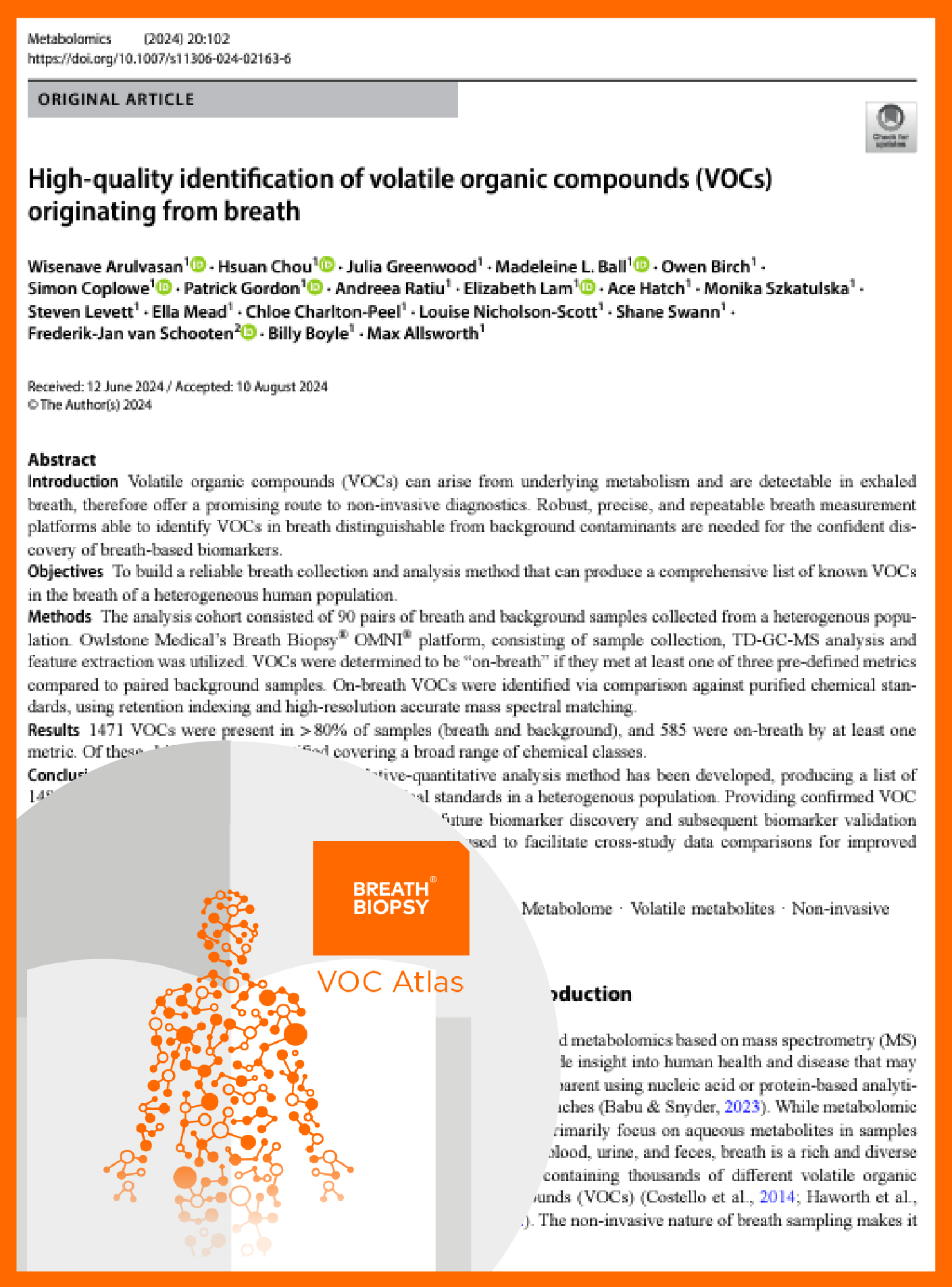How Exercise Affects VOCs detected in the Breath
Published on: 1 Aug 2024
Although it depends on the study, we usually ask participants to refrain from eating and exercising up to two hours before their breath sample is taken. This is because physical activity can have a significant impact on the VOCs that are detectable in the breath. In this blog, we delve into the literature to explore why volatile organic compounds (VOCs) in the breath can be affected by both short bouts of exercise as well as longer endurance events.
Since VOCs can be reflective of metabolic activity, they present a vast array of possibilities for non-invasive detection of acute changes in the inner workings of the body. In one study, participants were pushed to physical exhaustion using an indoor cycling ramp test, and several VOCs in the breath were significantly altered from baseline levels (1). At Max workload, the following VOCs increased significantly in concentration by the following percentages: isoprene (74%), methanethiol (25%), dimethylsulfide (35%), acetaldehyde (46%), butanal (21%), butyric acid (2%), and acetone (2%). Interestingly, some VOCs showed a significant increase at the onset of exercise but decreased as intensity increased. At its minimum, butanal decreased by 80%, acetaldehyde by 55%, isoprene by 25% and methanethiol by 75%. These then increased again during the cool down period, suggesting a causative effect of exercise.

Woman participates in indoor exercise testing. Curtesy of Getty Images.
The findings mirror those from another ramp test study (2). There, isoprene rose when participants began exercising, and they decreased again post exercise. Levels were lowest 10 minutes after exercise compared to 60 minutes after, as they had then returned to baseline. Multiple bouts of intense exercise also saw spikes with lower peaks in subsequent bouts, suggesting either isoprene depletion or a reduced capacity of production, perhaps due to inadequate recovery time.

Figure 2: Box and Whisper plots of exhaled isoprene levels for all participants (n = 33) at pre- and post-exercise timepoints. Note: IR = relative intensity; IS = internal standard, adapted from figure 2 in ramp test study (2).
What is the mechanism responsible for the link between exercise and isoprene levels in the breath?
Isoprene is the most abundant volatile hydrocarbon found in breath and was previously believed to be derived from cholesterol biosynthesis (via a mevalonate pathway in the liver) but is now known to be released at the onset of physical activity from muscular lipolytic cholesterol metabolism (3–5). Simply put, isoprene is a by-product of the process that mobilizes fat stores for energy by the muscles. The reason why this is important is because isoprene levels have been previously reported to change due to various disease states, oxidative stress, ageing and even sexual arousal (6), with studies noting unclear origins (4). Yet now that its origin has been confidently identified as musculoskeletal, its potential for applications in medicine and sports science is clearer (6).
We have discussed acute changes in VOCs following exercise, but what about changes over a longer period of exercise spanning several hours or days?
We recently published a paper with the Mayo Clinic looking at elite ultramarathon runners competing in the French Alps, running over 170km (7). In this study, 63 of 798 identified VOCs changed significantly between pre- and post-race concentrations, and 81% of the changes showed increased concentrations post-race. VOCs acetone and isoprene, both of which originate from lipid metabolism had a five-fold increase between pre- and post-race samples. Whilst the quickest source of energy derives from carbohydrates for most runners, these can quickly deplete, shifting energy production towards the use of lipids and amino acids, reflecting increased concentrations of associated VOCs after the race. Notably, acetate had the greatest proportional increase in the athletes post-race. It’s the most abundant short chain fatty acid (SCFA) and a product of lipid metabolism. Acetate can then be converted into Acetyl-CoA, which plays a key role in the production of ATP energy (8). SCFAs can also be produced from gut microbial activity and have been estimated to account for about 10% of caloric requirements in humans (9). Overall, the VOC changes in ultramarathoners suggest that exercise plays a key role in affecting lipid metabolism which has consequences for concentrations of commonly found VOCs in the breath.

Timeline of the breath testing procedure of ultramarathon runners
Why do contextual factors matter when sampling breath?
So far, we have discussed how VOCs such as isoprene change in their concentrations in response to exercise. Although, it is important to note that other factors also make a difference. Apart from behaviors that can change which VOCs are found in the breath, such as eating certain foods or using mouthwash immediately before taking a sample, VOC concentrations can be affected by individuals and their breathing rate, which can be altered due to exercise. Breathing faster allows less time for VOCs to saturate in air breathed out. If the breath collection procedure does not account for this factor, then it may bias the data and conclusions that are drawn from it. In a study that looked at forced expiratory volume (FEV) maneuvers, pronounced substance specific changes were found with a 21% increase in isoprene and 4.5% increase in acetone following maximum exhalation, even without exercising in the traditional sense (i.e. running). Furthermore, posture and positioning can change which VOCs are detected in exhaled breath. This is particularly relevant to exercise studies if breath samples were collected real-time as participants may be hunched over on an indoor bike, compared to being upright on a treadmill. They may also bend down to lean on something after physical protocols that push participants to exhaustion.
Exercise is an interesting area of VOC research with on-going efforts to better understand how the body responds to physical work. This builds on the evolving field of VOC discovery for biomarkers of disease and each subsequent set of findings can help improve our understanding of breath as a sampling medium. If you are interested in breath research, we offer state of the art products and services to ensure robust collection, detection and analysis of on-breath VOCs. Do not hesitate to contact us to learn more about how we can help.
References
- Pugliese G, Trefz P, Weippert M, Pollex J, Bruhn S, Schubert JK, et al. Real-time metabolic monitoring under exhaustive exercise and evaluation of ventilatory threshold by breathomics: Independent validation of evidence and advances. Front Physiol. 2022 Aug 12. doi: 10.3389/fphys.2022.946401
- Heaney LM, Kang S, Turner MA, Lindley MR, Thomas CLP. The Impact of a Graded Maximal Exercise Protocol on Exhaled Volatile Organic Compounds: A Pilot Study. Molecules. 2022 Jan;27(2):370. doi: 10.3390/molecules27020370
- Mochalski P, King J, Mayhew CA, Unterkofler K. A review on isoprene in human breath. J Breath Res. 2023 Apr;17(3):037101. doi: 10.1088/1752-7163/acc964
- Mochalski P, King J, Unterkofler K, Mayhew CA. Unravelling the origin of isoprene in the human body—a forty year Odyssey. J Breath Res. 2024 May;18(3):032001. doi: 10.1088/1752-7163/ad4388
- King J, Koc H, Unterkofler K, Mochalski P, Kupferthaler A, Teschl G, et al. Physiological modeling of isoprene dynamics in exhaled breath. Journal of Theoretical Biology. 2010 Dec 21;267(4):626–37. doi: 10.1016/j.jtbi.2010.09.028
- Sukul P, Richter A, Junghanss C, Schubert JK, Miekisch W. Origin of breath isoprene in humans is revealed via multi-omic investigations. Commun Biol. 2023 Sep 30;6(1):1–12. doi: 10.1038/s42003-023-05384-y
- Chou H, Arthur K, Shaw E, Schaber C, Boyle B, Allsworth M, et al. Metabolic insights at the finish line: deciphering physiological changes in ultramarathon runners through breath VOC analysis. J Breath Res. 2024 Feb;18(2):026008. doi: 10.1088/1752-7163/ad23f5
- Henderson B, Lopes Batista G, Bertinetto CG, Meurs J, Materić D, Bongers CCWG, et al. Exhaled Breath Reflects Prolonged Exercise and Statin Use during a Field Campaign. Metabolites. 2021 Mar 24;11(4):192. doi: 10.3390/metabo11040192
- Bergman EN. Energy contributions of volatile fatty acids from the gastrointestinal tract in various species. Physiological Reviews. 1990 Apr;70(2):567–90. doi: 10.1152/physrev.1990.70.2.567
